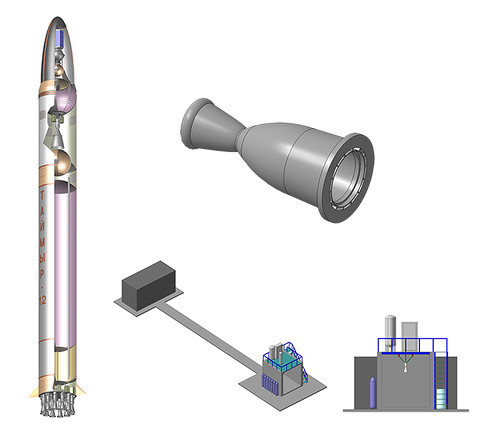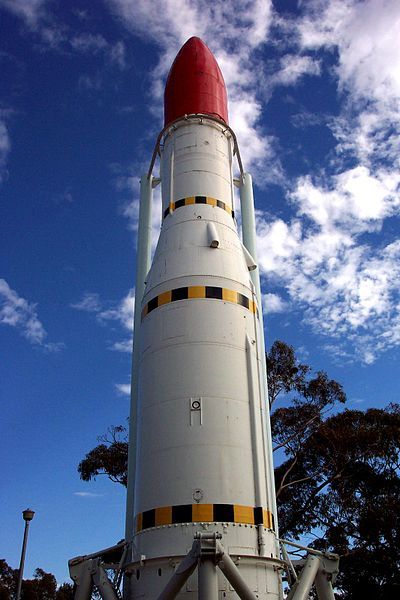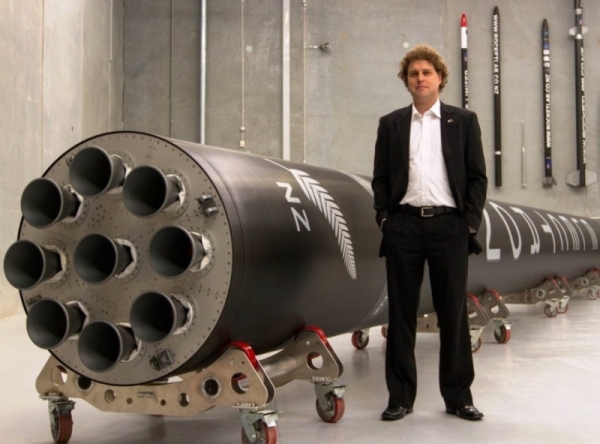"Lin Industrial" does not give up
Yesterday, a post with news about the company's plans appeared in the LiveJournal of the head of Lin Industrial, Alexander Ilyin. After the December accident and mysterious silence, any news from a domestic rocket start-up is valued almost its weight in gold. Let's try to try to analyze the new information.

A new type of launch vehicle "Taimyr", a new engine and a stationary stand, graphics "Lin Industrial"
First of all, the absence of any new information about the December incident is noteworthy. In my opinion, publicity in such cases helps rather than hinders, but Lin Industrial can act, as the lawyer says. The legal world lives by its own rules. After I read that Russia Today’s lawyers advise you not to comment on the detention of their journalist in the US, this version seems to me rather convincing. But in this case, we will not see the complete video of the accident and other interesting materials any time soon - the trial in court lasts for months. It's a pity.

New version of the “Taimyr” launch vehicle, graphics by A. Shlyadinsky
')
The main news is a change in the project of the ultralight launch vehicle Taimyr. If the previous version was similar to the small “Angara” with several universal rocket units and one engine on each, then in the new version they are going to implement the classic sequential arrangement of stages. At the first stage it is planned to install 12 engines of its own design with a 500 kg load. On the second - one engine 500 kg with high-altitude nozzle. And the third - a small solid-fuel engine. The carrying capacity of the launch vehicle is estimated at 20-30 kg to a low orbit, this is one microsatellite or up to three dozen cubes. It is planned to use concentrated hydrogen peroxide and kerosene as a fuel pair. From the point of view of payload, the layout and the selected fuel, the poured British launch vehicle Black Arrow (“Black Arrow”) is obtained.

Black Arrow, Wikipedia photo
The Black Arrow was the only British space launch vehicle launched 4 times (2 suborbital launches and two orbital launches, of which the latter was successful) in 1969-1971 and could bring up to 135 kilograms to low orbit. Alas, in 1971 there was no talk about nanosatellites, and such a low carrying capacity eventually put an end to the project. Black Arrow used the same kerosene peroxide fuel pair, several relatively low-power LREs and a third-stage solid fuel engine.
At the same time, the project "Taimyr" has not been without modern solutions. If, in the previous version, the components were to be supplied to the engine with a displacing feed, that is, pressurized gas from a separate tank, the new version assumes the use of electric pumps and lithium-ion batteries to power them. This idea is implemented in a private ultralight Electron booster, which will have to fly for the first time already this year.

PH Electron, photo: Rocket Lab
The development of an electric pump is much easier than creating a turbopump assembly, and the mass of the engines is comparable.
As for fuel, after the December accident on the Internet, the number of sofa rocket designers increased, many of whom condemned the choice of a peroxide-kerosene fuel pair. The problem is that rocket fuel must contain a lot of energy and active oxidizers of this energy, otherwise the rocket will not fly away. Therefore it is necessary to use any unpleasant stuff in work. Liquid oxygen is cold, hydrogen peroxide has a vile habit of self-decomposing, nitric acid produces toxic fumes. Personally, I would probably choose nitric acid from my rocket sofa, because my beloved OTRAG flew on it, and the pioneers of rocket technology used it quite successfully. But in fact, the question here is on a slightly different plane. If you follow the rules, you can successfully work with the most unpleasant poison of the type of asymmetric dimethyl hydrazine and successfully fly it for decades (hello, "Proton"). And if you violate the technology and do not think about safety, you can blow up the stand and kill people in tests without ignition, only on an oxidizer, as was the case at Virgin Galactic in 2007. So if “Lin Industrial” will comply with the technology and safety measures, will be able to fly successfully on anything.

Engine model, graphics "Lin Industrial"
Another change - the new engine at 500 pounds of thrust will use regenerative cooling instead of ablative. A full-fledged cooling jacket will appear in it, along which one of the components (in this case, almost certainly kerosene) will pass through before entering the combustion chamber and cool the engine. The combustion chamber is going to be manufactured by the method of selective laser sintering (actually, a 3D printer, only for metal).
And they are going to bring the pressure in the combustion chamber to 60 atmospheres, as much as the RD-107/108 engines for the Soyuz carrier rocket. Changing the type of cooling, Lin Industrial is following the path of Ilona Mask, who also first wanted to do ablative cooling, but then switched to regenerative one. Paradoxically, but more technically complex regenerative cooling is familiar and mastered, and ablative may require the search for new materials and additional research.
A 500 kg engine will not do immediately. First, they want to create a technological demonstrator for 100 kg of thrust and test it on a new stand. After the December accident, the idea of a mobile stand "Lin Industrial" refused and is now looking for a place under the stationary.

Stand Model, Graphics "Lin Industrial"
Due to the high cost of land in Moscow and the region, the options of creating a stand in the south of Russia or even in Cyprus are being seriously considered.
Alas, one not very pleasant conclusion follows from this news - “Lin Industrial” will not conduct a new test soon. Offhand, the development and creation of the engine and the construction of the stand will take at least a year and only after they have found money for it.
It is good that the money question rises in the post. More precisely, the financial situation of “Lin Industrial” is not good, but it’s good that they honestly tell us about it. On the one hand, according to Alexander, agreements with investors are in force, and they even agreed to allocate additional money in the spring, but right now there is no money to continue working, and more resources will be needed to create an industrial base and stand in the summer. Estimation of the required investment before the first start is about 400-500 million rubles, and, considering that Illyin himself writes about the erroneous understatement of the last estimates, this number can be easily multiplied by two. Will there be investors for a billion rubles? Alas, it is unknown.
If you want to support Lin Industrial, you can do this by buying their souvenirs. Also, they sell out the equipment that turned out to be superfluous after the move.
The December events dealt an extremely serious blow to the Russian rocket startup. Even without taking into account the direct loss of time and money, changes in projects will require additional costs. And if in 2016 one could hope for news about the launches of more and more powerful and heavy flying stands of Lin Industrial, then in 2017, it seems, the company will only be engaged in paper work and drawing drawings on a computer. Yes, of course, you can find positive aspects in that the team does not give up and is determined to move on. And, if the chosen road was wrong, then it’s good that they didn’t have time to go far. But the position of the company is still quite complicated, and it will only make it a miracle when investors fall from the sky with bags of money. Just the other day, the sad story of the failure of the Yaliny startup company, which was about to distribute the Internet from satellites, from which, I think, I learned rational, came out. If now “Lin Industrial” has free time, it would be worth trying to work out the reserve path of independent earnings by the existing team, in case the startup path fails to be realized due to the lack of investors. At least, this will continue the opportunity to return to space, even after years, earning from something else.

A new type of launch vehicle "Taimyr", a new engine and a stationary stand, graphics "Lin Industrial"
Secrets will not be revealed soon
First of all, the absence of any new information about the December incident is noteworthy. In my opinion, publicity in such cases helps rather than hinders, but Lin Industrial can act, as the lawyer says. The legal world lives by its own rules. After I read that Russia Today’s lawyers advise you not to comment on the detention of their journalist in the US, this version seems to me rather convincing. But in this case, we will not see the complete video of the accident and other interesting materials any time soon - the trial in court lasts for months. It's a pity.
"Black Arrow" meets "Electron"

New version of the “Taimyr” launch vehicle, graphics by A. Shlyadinsky
')
The main news is a change in the project of the ultralight launch vehicle Taimyr. If the previous version was similar to the small “Angara” with several universal rocket units and one engine on each, then in the new version they are going to implement the classic sequential arrangement of stages. At the first stage it is planned to install 12 engines of its own design with a 500 kg load. On the second - one engine 500 kg with high-altitude nozzle. And the third - a small solid-fuel engine. The carrying capacity of the launch vehicle is estimated at 20-30 kg to a low orbit, this is one microsatellite or up to three dozen cubes. It is planned to use concentrated hydrogen peroxide and kerosene as a fuel pair. From the point of view of payload, the layout and the selected fuel, the poured British launch vehicle Black Arrow (“Black Arrow”) is obtained.

Black Arrow, Wikipedia photo
The Black Arrow was the only British space launch vehicle launched 4 times (2 suborbital launches and two orbital launches, of which the latter was successful) in 1969-1971 and could bring up to 135 kilograms to low orbit. Alas, in 1971 there was no talk about nanosatellites, and such a low carrying capacity eventually put an end to the project. Black Arrow used the same kerosene peroxide fuel pair, several relatively low-power LREs and a third-stage solid fuel engine.
At the same time, the project "Taimyr" has not been without modern solutions. If, in the previous version, the components were to be supplied to the engine with a displacing feed, that is, pressurized gas from a separate tank, the new version assumes the use of electric pumps and lithium-ion batteries to power them. This idea is implemented in a private ultralight Electron booster, which will have to fly for the first time already this year.

PH Electron, photo: Rocket Lab
The development of an electric pump is much easier than creating a turbopump assembly, and the mass of the engines is comparable.
Around disgust
As for fuel, after the December accident on the Internet, the number of sofa rocket designers increased, many of whom condemned the choice of a peroxide-kerosene fuel pair. The problem is that rocket fuel must contain a lot of energy and active oxidizers of this energy, otherwise the rocket will not fly away. Therefore it is necessary to use any unpleasant stuff in work. Liquid oxygen is cold, hydrogen peroxide has a vile habit of self-decomposing, nitric acid produces toxic fumes. Personally, I would probably choose nitric acid from my rocket sofa, because my beloved OTRAG flew on it, and the pioneers of rocket technology used it quite successfully. But in fact, the question here is on a slightly different plane. If you follow the rules, you can successfully work with the most unpleasant poison of the type of asymmetric dimethyl hydrazine and successfully fly it for decades (hello, "Proton"). And if you violate the technology and do not think about safety, you can blow up the stand and kill people in tests without ignition, only on an oxidizer, as was the case at Virgin Galactic in 2007. So if “Lin Industrial” will comply with the technology and safety measures, will be able to fly successfully on anything.
New engine

Engine model, graphics "Lin Industrial"
Another change - the new engine at 500 pounds of thrust will use regenerative cooling instead of ablative. A full-fledged cooling jacket will appear in it, along which one of the components (in this case, almost certainly kerosene) will pass through before entering the combustion chamber and cool the engine. The combustion chamber is going to be manufactured by the method of selective laser sintering (actually, a 3D printer, only for metal).
And they are going to bring the pressure in the combustion chamber to 60 atmospheres, as much as the RD-107/108 engines for the Soyuz carrier rocket. Changing the type of cooling, Lin Industrial is following the path of Ilona Mask, who also first wanted to do ablative cooling, but then switched to regenerative one. Paradoxically, but more technically complex regenerative cooling is familiar and mastered, and ablative may require the search for new materials and additional research.
A 500 kg engine will not do immediately. First, they want to create a technological demonstrator for 100 kg of thrust and test it on a new stand. After the December accident, the idea of a mobile stand "Lin Industrial" refused and is now looking for a place under the stationary.

Stand Model, Graphics "Lin Industrial"
Due to the high cost of land in Moscow and the region, the options of creating a stand in the south of Russia or even in Cyprus are being seriously considered.
Alas, one not very pleasant conclusion follows from this news - “Lin Industrial” will not conduct a new test soon. Offhand, the development and creation of the engine and the construction of the stand will take at least a year and only after they have found money for it.
Damn question
It is good that the money question rises in the post. More precisely, the financial situation of “Lin Industrial” is not good, but it’s good that they honestly tell us about it. On the one hand, according to Alexander, agreements with investors are in force, and they even agreed to allocate additional money in the spring, but right now there is no money to continue working, and more resources will be needed to create an industrial base and stand in the summer. Estimation of the required investment before the first start is about 400-500 million rubles, and, considering that Illyin himself writes about the erroneous understatement of the last estimates, this number can be easily multiplied by two. Will there be investors for a billion rubles? Alas, it is unknown.
If you want to support Lin Industrial, you can do this by buying their souvenirs. Also, they sell out the equipment that turned out to be superfluous after the move.
Conclusion
The December events dealt an extremely serious blow to the Russian rocket startup. Even without taking into account the direct loss of time and money, changes in projects will require additional costs. And if in 2016 one could hope for news about the launches of more and more powerful and heavy flying stands of Lin Industrial, then in 2017, it seems, the company will only be engaged in paper work and drawing drawings on a computer. Yes, of course, you can find positive aspects in that the team does not give up and is determined to move on. And, if the chosen road was wrong, then it’s good that they didn’t have time to go far. But the position of the company is still quite complicated, and it will only make it a miracle when investors fall from the sky with bags of money. Just the other day, the sad story of the failure of the Yaliny startup company, which was about to distribute the Internet from satellites, from which, I think, I learned rational, came out. If now “Lin Industrial” has free time, it would be worth trying to work out the reserve path of independent earnings by the existing team, in case the startup path fails to be realized due to the lack of investors. At least, this will continue the opportunity to return to space, even after years, earning from something else.
Source: https://habr.com/ru/post/401709/
All Articles